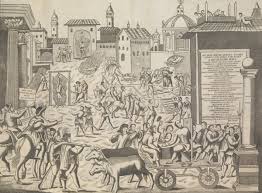Italy: How a city defeated plague centuries ago

Rome: The plague ravaged large cities and provincial towns in northern and central Italy from 1629 to 1631, killing more than 45,000 people in Venice alone and wiping out more than half the population of cities like Parma and Verona. But strikingly, some communities were spared.
In fact, the northern Italian town of Ferrara managed to prevent even a single death from the plague after the year 1576—even as neighboring communities were devastated. How did they do it? Critical in the city’s success, records suggest, were border controls, sanitary laws and personal hygiene.Starting with the catastrophic arrival of the Black Death in 1347, Italian cities gradually began to take proactive public health measures to isolate the sick, quarantine possible carriers and restrict travel from affected regions, says John Henderson, a professor of Italian Renaissance history at Birbeck, University of London, and author of Florence Under Siege: Surviving Plague in an Early Modern City.
Over the next three centuries, plague outbreaks were a regular occurrence in Italy’s densely populated cities, prompting increasingly coordinated and sophisticated responses. While Henderson says that the same general set of anti-plague measures were taken in cities across Italy, the town of Ferrara, population approximately 30,000, offers a fascinating success story.
A team of researchers at the University of Ferrara dug through municipal archives and historical manuscripts to uncover a Renaissance-era approach to “integrated disease management.” They credit Ferrara’s remarkable success to a combination of strict border surveillance, aggressive public sanitation and rigorous personal hygiene regimens that tapped the natural antimicrobial properties of herbs, oils and even scorpion and snake venom.
Ferrara is a picturesque walled city situated along a branch of the Po River halfway between Padua and Bologna, both badly affected by plague in 1630. A UNESCO World Heritage Site, Ferrara is distinguished for having some of the first paved roads in 1375 and a municipal sewer system since 1425.
Starting in the 15th century, Henderson says, large Italian cities like Venice and Florence stayed in constant communication with smaller towns like Ferrara to track the spread of new plague outbreaks. The information was used to set threat levels and coordinate public health responses.
In Ferrara, the highest threat level meant closing all but two of the city gates and posting permanent surveillance teams composed of wealthy noblemen, city officials, physicians and apothecaries. Anyone arriving at the city gates needed to carry identification papers called Fedi (“proofs”) to ensure they had arrived from a plague-free zone. Then they would be screened for any signs of disease.
Plague Hospitals Placed Outside the City’s WallsWithin the city, the same level of vigilance was employed to identify suspected cases of infection and move individuals into one of two lazaretti or plague hospitals located outside of Ferrara’s city walls. Similar plague hospitals in Florence treated over 10,000 patients during the Plague of 1630-31, all paid for by the state. Henderson says that physicians had long believed that plague was caused by “corrupt air,” which could be released from under the ground during earthquakes. Corruption was also caused by “putrefaction,” rotting matter and other filthy refuse in cities and the countryside.
In 1546, the Italian physician Girolamo Fracastoro published an influential text on contagion in which he took this theory a step further. “He developed an idea called ‘seeds of disease,’” says Henderson. “That’s how he envisioned disease being spread from person to person. Those seeds of disease had a sticky quality that could also adhere to clothes and objects.”
The public sanitation campaigns in cities like Ferrara emerged from a long tradition of medieval and sanitary legislation, further reinforced by Fracastoro’s theories of contagion. Streets were swept of garbage and cleared of “filthy” animals like dogs, cats and chickens (no mention of rats). Lime powder was spread liberally on any surface that may have come in contact with an infected person.Inside homes, residents tried a host of measures to disinfect objects and surfaces. Any damaged or cracked furniture was taken out and burned. Valuable objects and money were heated close to a fire and perfumes were sprayed throughout the house for 15 days. Clothing and other textiles were hung out in the sun, beaten and doused with perfumes.
For personal hygiene, the citizens of Ferrara turned to several popular natural remedies prescribed for protection against the plague. But they prized one above the rest: a medicinal oil called Composito. By law, a ready supply of Composito was to be stored in a locked box set into the wall of the municipal palace and only distributed in times of plague.
The secret recipe for Composito was concocted by the Spanish physician Pedro Castagno, who wrote Ferrara’s influential “Reggimento contra la peste” (“Regimen against the plague”), in which he described how the oily balm should be applied to the body.
“Before getting up in the morning, after lighting a fire of scented woods (juniper, laurel and vine shoots), warm the clothes and above all the shirt, rub first the heart region, near the fire to ease balm absorption, then the throat,” wrote Castagno. “[Afterwards], wash hands and face with acqua chiara (clean water) mixed with wine or vinegar of roses, with which sometimes all the body should be cleaned, using a sponge.”
Castagno never disclosed the ingredients used in making Composito, but by examining records of materials that Castagno ordered, researchers determined that the balm contained myrrh and Crocus sativus, both known for their antibacterial properties, as well as venom from both scorpions and vipers.
In fact, the recipe for Composito was not dissimilar to anti-plague regimens used in other parts of Italy, particularly “Oil of Scorpions” and an ancient ointment called Theriac, also made from viper venom.
“The choice to use venom is that only a true poison could combat the poison of plague,” says Henderson.
Centuries later, it’s hard to confirm that Ferrara’s specific combination of public health measures were indeed the secret to its success. Most Italian cities also applied the same rules and regimens in fighting the plague. The difference, says Henderson, may have lied in Ferrara’s level of enforcement.





